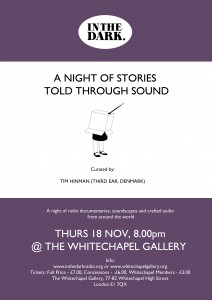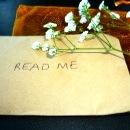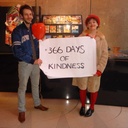 Just when I thought I was all listened-out, Third Ear took me to a higher aural plane.
Just when I thought I was all listened-out, Third Ear took me to a higher aural plane.
After two days of on and off-air radio dramas in the City University broadcast journalism department, a night of artisan Danish docu-radio was a daunting, if fitting, prospect. Continuing my recent spate of Thursday night culture vulturing, I shuffled along to the Whitechapel Gallery (only once fortified by a hot choc and Baileys at Brick Lane’s Cafe 1001, mind you).
A hundred or so radio lovers were herded into the stylish but cramped confines of a function room for In the Dark’s latest social listening soiree. And, pleasingly, we really were in the dark. Well nearly. The two previous ITD events I’d been to- a panel discussion on the future of radio in the digital age in a swanky Great Marlborough Street hotel (a venue ‘not befitting of radio’ as the girl next to me pronounced) and an altogether more boho evening in Dalston’s Passing Clouds dedicated to my personal audio favourite, The Hackney Podcast-were both bathed in an improper degree of light, both artificial and seasonally sunny. Firmly ensconced back in SAD- inducing Greenwich Meantime, it was a treat to snuggle up in a communal half light of the sort only really shared at teenage sleep-overs, Guide camp or in the theatre (air raid shelters and the Blitz-era black-out being on another level of darkness, obviously). The dimming of lights almost always brings with it a frisson of expectation- drawing theatre-goers back into the on-stage world after the glare of the interval, beckoning a live band or prompting juvenile ghost stories and heart to hearts under the covers (usually more Judy Blume than Jane Austen-esque in my experience, more’s the pity).
With the exception of titillating teen fiction, elements of all of the above were at work here, particularly as the evening’s programme gave little away- leaving us ‘in the dark’ in every sense! Bar the overarching authorship of Third Ear producer Tim Hinman, that is. In mellow tones he gave elliptcal and modest introductions to the six soundscapes handpicked from his archive. There was a welcome chronology to the set list, which opened with Hinman and his colleague Peter Kristiansen’s early experiments in sound art. These were made, surprisingly, for Danish public radio’s apparently progressive features department at the beginning of the last decade. The cascade of recurring SFX motifs in ‘Gentle Waves the Break’ exemplifed the ‘non-journalistic, non-presentational’ approach which ‘lets the listener decide,’ as Hinman elucidated, as opposed to the narrative didacticism of traditional documentary. He began his career as a sound designer for film- notably working with Lars von Trier- inspired by the Nordic sound poetry of Per Hojholt’s ‘Turbo- a space fiction,’ which he characterised as ‘Pam Ayres meets Jimmy Hendrix.’ Those two cultural heavyweights aside, my nearest reference point for the burst of near-impenetrable psychedelic cacophony was the Czech band Plastic People of the Universe. Their accidental agitprop only came to my attention having been sampled to great effect in Tom Stoppard’s 2006 stage play Rock n’Roll, of course. Close, but with a cultural and political chasm in between, I fear…

Thankfully, at this juncture Hinman’s work took a turn for the accessible, if not the conventional. ‘Japanese Hi Fi’ from 2000 featured fleeting, looped snatches of narration in English- the first we’d been treated to so far. A Lost In Translation sound tour evoking culture clash and the allure/ alienation of exoticism, it stopped short of pretension through a healthy dose of humour and honesty, reflecting on the very inability of the tourist/sound artist to capture and reconcile the contradictory essence of travel.
Next came Atomised, a 2004 English/ Danish work in which Hinman sought to ‘balance sound and telling.’ Archival monologue clips of Danish physicist Niels Bohr were intercut with those of ‘father of the atom bomb’ J.Robert Oppenheimer over a bed of cosmic, trippy production- a racy audio companion piece for Michael Frayn’s Tony Award winning Copenhagen, perhaps?
After some ‘edu-tainment’ quipping, Hinman graciously indulged his predominantly English-speaking audience with a gentle, 12-minute long doc, ‘The Seducer’s Guide to the Lonely Planet.’ The first person, narrator-driven soul searching of US journalist Benjamin Walker was a collaboration with Dane Pejk Malinovski, as the former set out to get to the bottom of Kierkegaard’s ‘religious stage.’ Part This American Life, part In Our Time with a dash of From Our Own Correspondent, the premise of one man’s philosophical quest motivated an easily digestible, cross cultural exchange of ideas and foibles. It was a refreshingly pared down, ruminative piece that served as a potted history of the Danish Existentialist for uninitiated such as myself.
The final and most recent helping of audio was Hinman’s own ‘The Garden’, a consummate, 47 minute radio feature that was as entertaining as it was self aware. The opening felt like a tried and tested audio doc, the starting point being the 2010 fire in Dehn’s Palace, which in turn uncovers the fragmentary story of a murdered pregnant woman, the incriminating anatomical drawings of the subject/ victim being unearthed during the subsequent clean up and restoration. Fragmentary is the key here, as the evidence soon runs out. Plenty of clues and hunches are thrown up as Hinman delves into Copenhagen’s Frederiksstaden quarter, but the facts are thin on the ground. Where most documentary makers might see a dead end, Hinman sees an opportunity for a meta-docu-drama. This departure from fact to fiction is made immediately transparent to the listener: ‘Now that I’ve found a place that has a story… if I was to tell this story, it would start like this…’ Cue SFX signifiers of gothic melodrama- rain, footsteps on cobble stones, heavy breathing. So begins the story within a story that wears its contrivance on its sleeve as Hinman enlists the help of a film director, a novelist and a historian to act as consultants on everything from genre to plot, script to characterisation. Pitches featuring body snatchers, pimps, depraved surgeons, royalty, cults, romance and revenge tragedy are in turn floated and rejected as variously brilliant/implausible/ impossible. With shades of his former employer von Trier circa-Dogville discernible, I’m also reminded of Martin Amis’ Centre Pompidou analogy- for art that shows the nuts and bolts of its workings on the surface. Potentially pompous and baffling, but potentially generous and self-deprecating, too.
Its creator warned us that ‘The Garden’ has been branded ‘postmodern’, whereas he had hoped it might have got at least one prefix beyond that. In never taking itself too seriously, I believe it has.
Photographs by Kirsty McQuire






